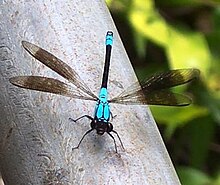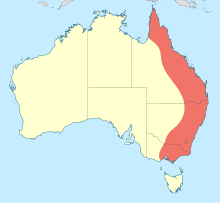Diphlebia is a genus of damselflies in the family Lestoideidae.[2] They are commonly known as rockmasters. These damselflies are very large and thick. The species in this genus are found in Eastern Australia, except for one species that can be found in New Guinea. The males are vividly patterned. They are blue or bluish green and black in colour. Their blue colour also gives them the name azure damselflies. They rest with their wings spread out. Their wings are usually blackish brown or have white markings. These damselflies have several present antenodal crossveins. The two basal crossveins extend across costal and subcostal spaces.
| Rockmasters | |
|---|---|

| |
| Tropical rockmaster | |
| Scientific classification | |
| Domain: | Eukaryota |
| Kingdom: | Animalia |
| Phylum: | Arthropoda |
| Class: | Insecta |
| Order: | Odonata |
| Suborder: | Zygoptera |
| Family: | Lestoideidae |
| Genus: | Diphlebia Selys, 1869[1] |

| |
Diphlebia larvae are wide and flat. They have long saccoid gills enabling them to breathe underwater. The inner tooth of their labial palps is elongated. The specific characters of the larvae are mid-ventral, distal width, basal width, and length of median lobe.
Species
editDiphlebia includes five species that are found in eastern Australia and New Guinea. The following are the species.
- Diphlebia coerulescens Tillyard, 1913 - sapphire rockmaster
- Diphlebia euphaeoides Tillyard, 1907 - tropical rockmaster
- Diphlebia hybridoides Tillyard, 1912 - giant rockmaster
- Diphlebia lestoides (Selys, 1853) - whitewater rockmaster
- Diphlebia nymphoides Tillyard, 1912 - arrowhead rockmaster
Notes
editUntil recently Diphlebia was a member of the family Diphlebiidae.
References
edit- ^ Selys-Longchamps, E. (1869). "Secondes additions au synopsis des Caloptérygines". Bulletin de la Classe des Science, Académie Royale de Belgique (in French). 27: 645–680 [662] – via Biodiversity Heritage Library.
- ^ "Genus Diphlebia Selys, 1869". Australian Faunal Directory. Australian Biological Resources Study. 2012. Retrieved 4 April 2017.
- "DIPHLEBIIDAE - Azure Damselflies". Brisbane Insects and Spiders. Retrieved 12 October 2010.
- Günther Theischinger; John Hawking (2006). The Complete Field Guide to Dragonflies of Australia (PDF). CSIRO Publishing. ISBN 0-643-09073-8. Retrieved 11 August 2010.
- Martin Schorr; Martin Lindeboom; Dennis Paulson. "World Odonata List". University of Puget Sound. Retrieved 11 August 2010.